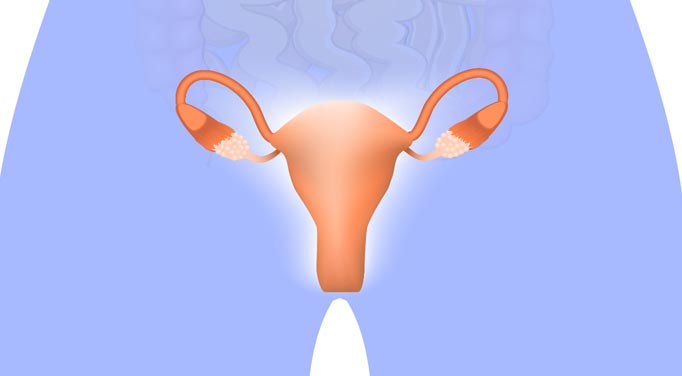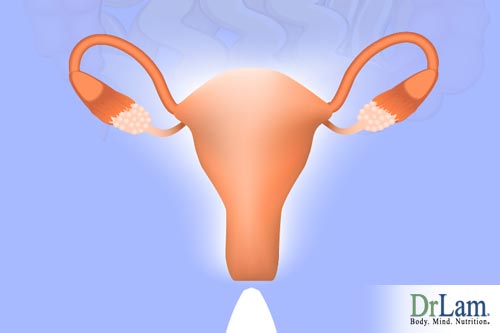 Uterine fibroids (uterine leiomyomata) are non-cancerous tumors consisting of fibers or fibrous tissue that arise in the uterus. It is the most common growth of the female genital tract. These tumors are highly sensitive to estrogen. They develop following the onset of menstruation and enlarge during pregnancy. Age will shrink fibroids, often disappear after menopause when estrogen levels are decreased by half. They can be as small as a hen's egg, or commonly grow to the size of an orange or grapefruit. The largest fibroid on record weighed over 100 pounds. It afflicts many women, especially from age 35 to 50. One in 5 women in the U.S. has at least some evidence of fibroids. Discovery is usually accidental and coincidental with a heavier period, irregular bleeding, and or painful periods. A few simple life changes can help you shrink fibroids.
Uterine fibroids (uterine leiomyomata) are non-cancerous tumors consisting of fibers or fibrous tissue that arise in the uterus. It is the most common growth of the female genital tract. These tumors are highly sensitive to estrogen. They develop following the onset of menstruation and enlarge during pregnancy. Age will shrink fibroids, often disappear after menopause when estrogen levels are decreased by half. They can be as small as a hen's egg, or commonly grow to the size of an orange or grapefruit. The largest fibroid on record weighed over 100 pounds. It afflicts many women, especially from age 35 to 50. One in 5 women in the U.S. has at least some evidence of fibroids. Discovery is usually accidental and coincidental with a heavier period, irregular bleeding, and or painful periods. A few simple life changes can help you shrink fibroids.
In cases where the tumor's size compromises other bodily function such as compression on the bladder or excessive bleeding, surgery may be indicated. The most common surgery is the hysterectomy where the uterus is removed. Many hysterectomies, however, are performed way before the patient reaches this stage. In fact, over 500,000 hysterectomies are performed every year in the U.S. alone.
Dr. Stanley West, chief of reproductive endocrinology and infertility at St. Vincent's Hospital in New York and author of The Hysterectomy Hoax, strongly believes that hysterectomy is seldom indicated unless a woman has cancer. Looking back at history, it is interesting to note that until unopposed estrogen was given as hormone replacement therapy in the mid-1960s, uterine (endometrial) cancer was very rare. We now know that endometrial cancer is clearly linked to unopposed estrogen. Most commonly, endometrial cancer begins about 5 years before the onset of menopause during the pre-menopausal period, when estrogen is still plentiful.
During the pre-menopausal period, the amount of estrogen is still relatively high while the level of progesterone is dropping quickly, compared to before. Remember that estrogen and progesterone are the two balancing female hormones and balance is important if one is to shrink fibroids. One opposes the other. It is this balance that is critical in maintaining optimum female health. When the drop in progesterone is faster than the drop in estrogen
Estrogen dominance occurs because of several reasons. First, many women in their mid-thirties begin to have anovulatory (non-ovulating) menstrual cycles. These periods can be verified by checking serum or saliva progesterone levels the week following supposed ovulation. A low reading indicates a lack of ovulation. Without ovulation, the all importance progesterone is not secreted, and the body is flooded in a sea of estrogen, setting up an estrogen dominant environment. Second, even if the menstrual cycle is normal, as a woman approaches the decade before menopause, the amount of progesterone produced is much less in comparison to estrogen. As a result, the estrogen/progesterone ratio is increased. Thirdly, our body is exposed to environmental estrogen found in our food and household goods. 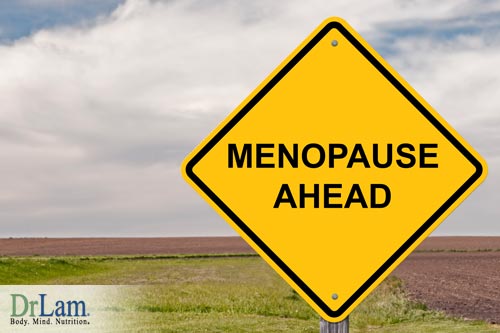 Commercially grown vegetables contain pesticide residues whose chemical structure is similar to estrogen, and commercially raised cattle and poultry are fed with a variety of hormones. Petrochemical compounds found in general consumer products such as creams, lotions, soaps, shampoos, perfume, hair spray, and room deodorizers are omnipresent. Such compounds often have chemical structures similar to estrogen. Lastly, chronic stress experienced by the modern woman leads to adrenal exhaustion and a reduced output of progesterone. The end result is clear - We live in an estrogen dominant world. This is the estrogen dominance that is a strong causative factor. Learning to regulate the hormones can help shrink fibroids.
Commercially grown vegetables contain pesticide residues whose chemical structure is similar to estrogen, and commercially raised cattle and poultry are fed with a variety of hormones. Petrochemical compounds found in general consumer products such as creams, lotions, soaps, shampoos, perfume, hair spray, and room deodorizers are omnipresent. Such compounds often have chemical structures similar to estrogen. Lastly, chronic stress experienced by the modern woman leads to adrenal exhaustion and a reduced output of progesterone. The end result is clear - We live in an estrogen dominant world. This is the estrogen dominance that is a strong causative factor. Learning to regulate the hormones can help shrink fibroids.
While a fibroid in itself does not usually lead to cancer or become cancerous, it clearly signals a serious underlying imbalance in the woman's reproductive and hormonal system. Specifically there is an estrogen dominance and progesterone deficiency. Such imbalances do not only affect the uterus, but affect other hormone sensitive tissues such as breast, cervix, ovaries and the vagina as well. If measures are taken to shrink fibroids, the condition may be resolved. If not taken care of, the consequences can be devastating.
The typical story goes something like this:
Jane started experiencing symptoms of Pre-menstrual Syndrome (PMS) during her monthly menstrual cycle in her late twenties and thirties. She has some headaches, bloating, cramps, and feels irritable, but she can handle it. Sometimes she takes a pain killer to get rid of the symptoms and nothing more is done. Little did she know that PMS is a sign of estrogen dominance.
As the years go by, her period becomes heavier and cramps are more severe. A routine check-up indicates small fibroids present in her uterus. No action is needed, she was told by her doctor, as the tumor is benign and unless she is bleeding heavily, just leave it alone. Her doctor does not discuss how to treat or shrink fibroids. Little did she know that continued unopposed estrogen dominance is making the fibroid grow without her knowledge.
A few years later, when she is in her early forties, the fibroid is causing her to bleed heavily and pressing on her bladder. What is the standard medical treatment? Hysterectomy. She did not know better, and her uterus is removed, often times with the ovaries.
After the surgery, she is cycled on hormone replacement therapy. She may be given a combination pill of synthetic estrogen and synthetic progesterone. More likely than not, she is given estrogen only (such as Premarin), setting up an unopposed estrogen environment. Jane thinks that her problems are solved since her uterus is removed. She does not know that the story is far from over and in fact is getting worse.
When Jane goes through menopause, everything seems to be under control. Her symptoms are controlled with estrogen replacement therapy. Jane did not realize that the drop in estrogen is only 50% during this period, while the drop in progesterone during menopause is 99%. While the absolute level of estrogen is less in the body, her cells are exposed to excessive estrogen due to the severe deficiency of progesterone during menopause. Any estrogen she gets from her doctor will only stimulate her already estrogen sensitive cells to grow out of control.
Little did she know that the worse was yet to come. Some years later, as early as 1-2 years, she felt a lump on her breast. Biopsy confirms it to be a malignant tumor. Now she needs radical surgery and possibly chemotherapy. Jane has set herself up for cancer from 20 years of neglect of the signals the body has been sending her to warn her of hormonal imbalance and estrogen overload. She is now at a loss on how she can develop breast cancer when her uterus has been removed and she is supposed to be "cancer free".
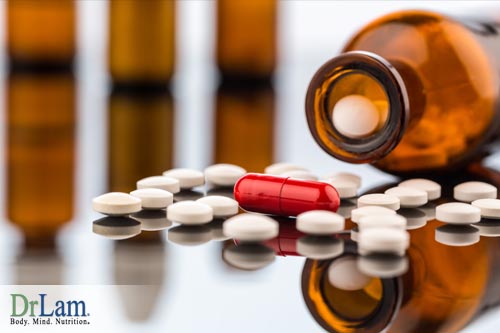 Estrogen dominance is the leading cause of fibroids and a precursor to a hormonal sensitive tumor. This condition is an epidemic largely ignored by conventional medicine. For this reason, preventive steps and early intervention is highly advisable.
Estrogen dominance is the leading cause of fibroids and a precursor to a hormonal sensitive tumor. This condition is an epidemic largely ignored by conventional medicine. For this reason, preventive steps and early intervention is highly advisable.
Fibroids are promoted by persistently high estrogen production. Without the monthly balancing effect of progesterone, the uterus continues to grow. Prevention and treatment to shrink fibroids from a non-surgical perspective should, therefore, focus on reducing the level of estrogen in the body as well as increasing the level of progesterone (the antagonist to estrogen) level within.
What most doctors don't know is that the application of natural progesterone cream is highly effective to shrink fibroids enough to minimize or eliminate symptoms long enough to get to menopause, or when it will normally shrink significantly enough to cease being a problem. The key is to apply natural, and not synthetic, progesterone. Let us take a look at the difference.
The natural form of progesterone, derived from wild yam, is very different from the synthetic unnatural form, made in a laboratory (the widely prescribed Provera). The synthetic version is a chemical compound called "progestin". It is a prescription drug commonly used in small amounts to balance the estrogen effect in a hormone replacement program. Being a drug, progestin is far more powerful than a woman's natural progesterone. It is metabolized in the liver into toxic metabolites which, if excessive, can severely interfere with the body's own natural progesterone. This creates other hormone-related health problems and further exacerbates into estrogen dominance.
On the other hand, natural progesterone is obtained by extracting diosgenin from wild yams and then converting this component into natural progesterone in the laboratory. Natural progesterone is referred to as natural because it is the identical molecule to that which the human body manufactures. Such yam-derived natural progesterone should not be confused with "yam extracts" that are commonly sold in health food stores. Our body easily converts natural progesterone into the identical molecule made by the body. It cannot convert the "yam extracts" into progesterone. There is no evidence that such wild yam extract is converted into progesterone once it enters into the human body and unlike natural progesterone, no conclusive formal studies have ever been conducted that identifies any particular benefits from wild yam extracts.
The goal is to restore the normal physiological progesterone level in your body for two to three weeks out of a month the way it was designed by Mother Nature. An ovulating woman makes about 20 mg a day for about 12 days each month after ovulation. That works out to about 240 mg per month.
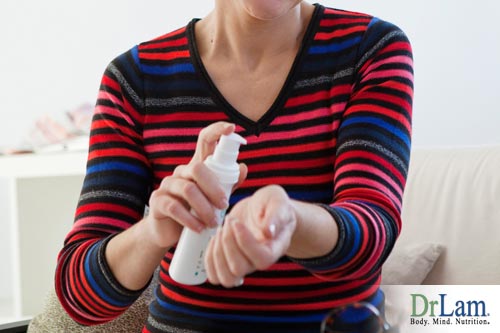 Locate a progesterone cream that supplies 480 mg per ounce (960 mg per 2 ounce). This means that the each two-ounce jar or tube will contain 3 percent by volume or 1.6 percent by weight of USP progesterone. Using one ounce over two or three weeks will provide about 240 mg if the absorption is 50 percent. This is the ideal target dose to apply. This works out to 1/8 to 1/2 teaspoon of the cream per day, or three to 10 drops of it in oil form, or one pump full with the metered pump dispensing top.
Locate a progesterone cream that supplies 480 mg per ounce (960 mg per 2 ounce). This means that the each two-ounce jar or tube will contain 3 percent by volume or 1.6 percent by weight of USP progesterone. Using one ounce over two or three weeks will provide about 240 mg if the absorption is 50 percent. This is the ideal target dose to apply. This works out to 1/8 to 1/2 teaspoon of the cream per day, or three to 10 drops of it in oil form, or one pump full with the metered pump dispensing top.
The best way to tell if the cream is working is whether your symptoms are relieved.
No known side effects exist when using natural progesterone in physiological amount under normal conditions. Too much progesterone can cause an anesthetic and drunken effect such as slight sleepiness. Simply reduce the dosage until the sleepiness dissipates. Some women report estrogen dominance symptoms for the first week or two after starting progesterone. This is normally caused by a sensitization of estrogen receptors that generally resolve spontaneously within a few weeks.
It is important to be as accurate as possible when applying progesterone cream. The best low dose progesterone cream should contain 1.7% of progesterone and yield 20 mg or progesterone per application. The simplest application method is through the use of a metered pump that measures the exact amount each time the pump is pressed.
Progesterone is best absorbed where the skin is relatively thin and well supplied with capillary blood flow. Areas such as the face, neck, upper chest, breast, inner arms, and thighs are good areas. Spread it out to as large an area as possible for maximum absorption, and allow as much time for absorption as possible. Therefore apply at bedtime if you are applying it once a day. Applying twice a day is ideal but it may be too troublesome for most. Rotate to different areas in order to avoid saturation in any one particular site.
Practically speaking, the best gauge to of an ideal dosage should be determined by laboratory test and on relief of symptoms. The right dose is the dose that works.
Women in premenopause - still ovulating:
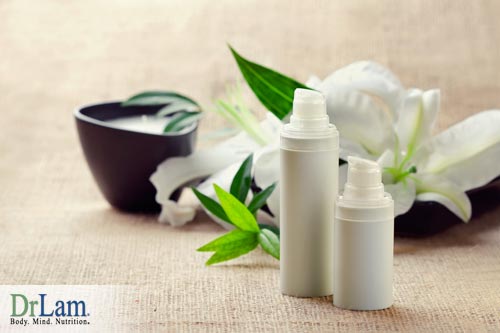 Directions for those on synthetic progesterone (progestin) supplementation: Taper off the synthetic progesterone gradually and replace with natural progesterone over a 3-6 month period. Synthetic progesterone can be reduced to every other day and then further taper off.
Directions for those on synthetic progesterone (progestin) supplementation: Taper off the synthetic progesterone gradually and replace with natural progesterone over a 3-6 month period. Synthetic progesterone can be reduced to every other day and then further taper off.Women in perimenopause (still menstruating with menopausal symptoms and/or PMS but not ovulating):
Overeating and under-exercise is the norm in developed countries. Population from such countries, especially in the Western hemisphere where a large part of the dietary calorie is derived from fat, has a much higher incidence of menopausal symptoms. Studies have shown that estrogen levels fell in women who switched from a typical high fat, refined carbohydrate to a low-fat, high-fiber, plant-based even though they adjusted their total calorie intake. Plants contain over 5000 known sterols that have progestogenic effects. Cultures whose eating habits are more wholesome and exercise more have a far lower incidence of menopausal symptoms because their pre and post menopausal level of estrogen does not drop as significantly.
In a non-industrialized society not subject to environmental estrogen insults,
progesterone deficiency is rare. During menopause, sufficient progestogenic substance is circulating in the body in order to keep the sex drive unabated, bones strong, and symptom-free passage through menopause.
A plant based whole unprocessed food diet is recommended to help shrink fibroids. At least 30 grams of fibers should be consume a day. Avoid high glycemic foods such as refined sugar. Avoid alcohol or drugs which can damage the liver and will lead to an increase in estrogen due to the lack of estrogen breakdown. Caffeine intake from all sources was linked with higher estrogen levels regardless of age, body mass index (BMI), caloric intake, smoking, and alcohol and cholesterol intake, which can hurt the efforts to shrink fibroids. Studies have shown that women who consumed at least 500 milligrams of caffeine daily, the equivalent of four or five cups of coffee, had nearly 70% more estrogen during the early follicular phase than women consuming no more than 100 mg of caffeine daily, or less than one cup of coffee.
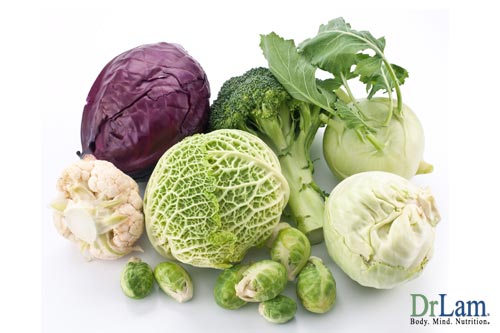 Elevated estrogen levels can be neutralized by a reduction of estrogen exposure through a proper wholesome fresh whole food diet, especially a diet rich in cruciferous vegetables such as broccoli, cauliflower, cabbage, kale, bok choi, and Brussels sprouts. Eat at least 3- 5 servings of these important vegetables a week.
Elevated estrogen levels can be neutralized by a reduction of estrogen exposure through a proper wholesome fresh whole food diet, especially a diet rich in cruciferous vegetables such as broccoli, cauliflower, cabbage, kale, bok choi, and Brussels sprouts. Eat at least 3- 5 servings of these important vegetables a week.
Fortunately, scientists are able to isolate the active ingredient of cruciferous vegetables that help to shrink fibroids. It is called Indole-3-Carbinol (I3C). Unfortunately, I3C has drawbacks. Numerous studies have shown that I3C, and in particular its reaction product ICZ, are associated with a number of unwanted activities that are not compatible with safe, long-term use. I3C supplementation is not recommended. Fortunately, I3C combines with stomach acid to form 3,3-Diindolylmethane (DIM). DIM supplementation is available and it is safe to use to shrink fibroids.
DIM is a balancer of estrogen metabolism and that balance is a key to shrink fibroids. Let us review the pathway of estrogen metabolism first. Estrogen is metabolized in the liver. One of its metabolites - 16 alpha hydroxy estrone - is a carcinogenic metabolite implicated in propagating and promoting many hormone-sensitive cancers. Studies have shown that it was not the absolute amount of it, but the ratio of another estrogen metabolite called 2 hydroxy estrone to 16 alpha hydroxy estrone, that was the more important predictor of cancer risk. The 2 hydroxy estrone is therefore known as the good or protective estrogen, and the 16 alpha hydroxy estrone has been deemed to be the bad or carcinogenic estrogen. One of the most efficient and healthiest ways to increase the ratio of these estrogen metabolites in favor of the good estrogen is to eat large quantities of cruciferous vegetables or take DIM supplements, which will help shrink fibroids.
Over 40 studies on DIM are on file in the National Library of Medicine database. As little as 0.5mg/kg body weight/day of DIM has been demonstrated as an effective dose. DIM can be used in conjunction with phyto-estrogens such as isoflavones. Its use is cautioned in women taking the oral contraceptive as it theoretically may reduce its effectiveness.
The use of DIM is compatible with other phyto-nutrients such as soy, black cohosh, red clover, and chaste berry extract.
Especially popular in recent years is soy products, a plant-based phytoestrogen that is 500 times weaker than the body's estrogen. The active ingredient is isoflavone, which acts as a competitive inhibitor of regular estrogen. By binding itself to the cell's estrogen receptor site, the body's estrogen is unable to penetrate. The estrogen load in the body is reduced. More than 1,000 medical and scientific papers have been published on isoflavones and soy. There are three primary isoflavones in soybeans: genistein, daidzain, and glycitein. In various experimental models, isoflavones have exhibited properties that suggest they may help to lower the risk of cancer, heart disease, osteoporosis, and for the relief of menopausal symptoms such as hot flashes. In addition to breast cancer, soybean isoflavones may help reduce the risk of several types of cancer, including lung, colon and rectal cancer. As a result, soy products have been heavily promoted in recent years. It should be noted that unless soy is fermented (such as miso or tempeh), intake of unfermented soy (such as tofu) could do more harm than good in our body due to its toxic metabolites if an excess amount is eaten. Isoflavone extracts do not have this problem.
Isoflavone and DIM work under different pathways. While studies have shown that supplementation with 200 mg/day of soy isoflavones increase the production of estrogen metabolites, the effect is much less than that seen with absorbable DIM. From a nutritional supplementation perspective, both DIM and isoflavone supplement should be considered, both in optimum and not mega doses.
Estrogen is metabolized in the liver. Herbs that fortify the liver will speed up estrogen clearance from the body. Estrogen that is not metabolized by the liver will continue to circulate and exert its effect on the body.
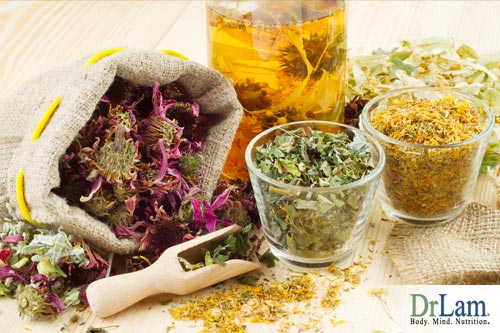 The most impressive research has been done on a special extract of milk thistle (Silybum marianum) known as silymarin, a group of flavonoid compounds. These compounds protect the liver from damage and enhance the detoxification process.
The most impressive research has been done on a special extract of milk thistle (Silybum marianum) known as silymarin, a group of flavonoid compounds. These compounds protect the liver from damage and enhance the detoxification process.
Silymarin prevents damage to the liver by acting as an antioxidant. It is much more effective than vitamin E and vitamin C. Numerous research studies have demonstrated its protective effect on the liver. Extremely toxic chemicals such as carbon tetrachloride, amanita toxin, galactosamine and praseodymium nitrate produce experimental liver damage in animals. Silymarin has been shown to protect the liver against these toxins.
Silymarin also works by preventing the depletion of glutathione. The higher the glutathione content, the greater the liver's capacity to detoxify harmful chemicals. Moreover, silymarin has been shown to increase the level of glutathione by up to 35 percent. In human studies, silymarin has been shown to exhibit positive effects in treating liver diseases of various kinds including cirrhosis, chronic hepatitis, fatty infiltration of the liver, and inflammation of the bile duct. The common dosage for silymarin is 70 to 200 mg one to three times a day.
In addition, avoid caffeine, alcohol, and medications that interfere with the liver's detoxification mechanism.
Key antioxidants to fight fibroids include Vitamin C 3-8 grams a day, beta-carotene 50,000-150,000 IU a day, selenium 200-400 mcg a day and zinc 30-50 mg a day.
In addition to fortifying the liver, a regular body detoxification process should be instituted.
If you are overweight then lose the excess weight, as fat cells increase estrogen production. Finally avoid alcohol or drugs because they can damage the liver which will inevitably lead to an increase in estrogen due to the lack of estrogen breakdown.
Uterine fibroid is a warning sign from our body of a hormonal imbalance. There are natural ways to shrink fibroids and rebalance hormones. It can easily be treated with lifestyle adjustments, nutritional supplementation, and natural progesterone cream, most of the time. Surgeries are seldom necessary. The underlying cause is, frequently, estrogen dominance, which can also lead to a variety of other hormone related diseases such as breast and cervical cancer if not properly controlled. On the first sign of estrogen dominance, preventive steps should be instituted. Maintaining a normal estrogen level is key to hormonal health for all adult women.
© Copyright 2012 Michael Lam, M.D. All Rights Reserved.
